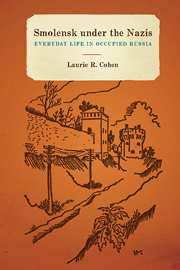Book contents
- Frontmatter
- Contents
- Acknowledgments
- Abbreviations
- Introduction
- Part 1 Methodologies
- Part 2 A Record of the War and Occupation
- Part 3 Popular Attitudes, Propaganda, and Enemy Imagery
- Part 4 Restoration and Reconstruction
- 10 Liberation and Revival
- 11 Interrogations, War Crimes Trials, and the Making of War History
- Conclusion
- Notes
- Bibliography
- Index
10 - Liberation and Revival
from Part 4 - Restoration and Reconstruction
Published online by Cambridge University Press: 05 December 2013
- Frontmatter
- Contents
- Acknowledgments
- Abbreviations
- Introduction
- Part 1 Methodologies
- Part 2 A Record of the War and Occupation
- Part 3 Popular Attitudes, Propaganda, and Enemy Imagery
- Part 4 Restoration and Reconstruction
- 10 Liberation and Revival
- 11 Interrogations, War Crimes Trials, and the Making of War History
- Conclusion
- Notes
- Bibliography
- Index
Summary
Muscovites will never forget the glorious city of Smolensk! Every day we looked painfully westward, repeating to ourselves: ‘There's Smolensk!’ And that was our vow …to return you to the family of ancient Russian cities.
—Komsomol'skaia Pravda, September 1943In early 1943, as the German-Soviet front shifted westward, Heinrich Himmler ordered the Wehrmacht to evacuate and take with them from the occupied Soviet territories “first the eligible working men, and then the eligible women, as work forces in Germany.” Himmler also wanted to evacuate “collaborating” Soviets, because “we owe these people who have helped us our protection.” By contrast, Wilhelm Kube, German general commissar for “White Ruthenia,” argued around the same time for remaining in the territories and acting more humanely: “If we wish to stay on these territories, pushing the borders up to Smolensk, then we must also demonstrate some political responsibility toward the population. If we continue doing what we are doing [shooting people who refuse to be recruited for work in the Reich], then we are responsible for the regression of Kultur and civilization.” Human lives were to be respected, in other words, while simultaneously the German leadership began to conduct a scorched-earth campaign in these very same occupied Soviet territories. One wonders how the destruction of land and equipment—yet another ruthless policy wherein “whatever could not be taken [by Nazi-German forces] should not be left for anyone else, either”—squared with the human dignity that Kube proposed.
- Type
- Chapter
- Information
- Smolensk under the NazisEveryday Life in Occupied Russia, pp. 235 - 246Publisher: Boydell & BrewerPrint publication year: 2013

